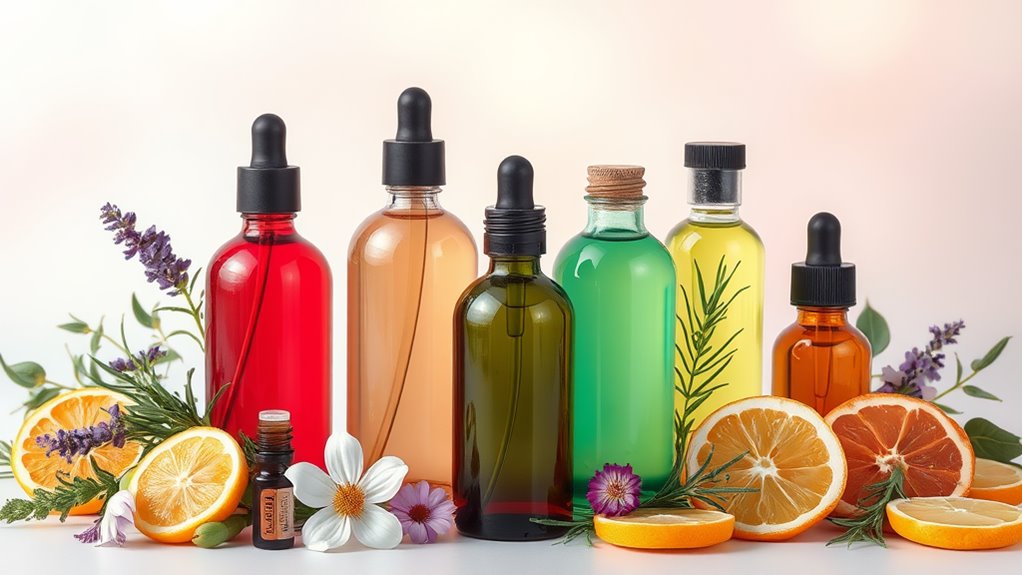Essential Oils That Do Wonders for Dry Skin
If you’re struggling with dry skin, essential oils might be just what you need. These natural remedies offer a range of benefits, from soothing irritation to enhancing skin elasticity. Whether you’re looking to balance oil production or fight bacteria, there’s an oil that can help. Let’s explore some of the most effective options and how you can customize them to create a skincare routine that truly rejuvenates your skin.
Key Takeaways
- Lavender Essential Oil soothes dry skin with its calming properties and reduces redness through anti-inflammatory effects.
- Tea Tree Essential Oil combats bacteria and fungi, promoting skin healing and balancing oil production to prevent clogged pores.
- Frankincense Essential Oil offers anti-aging benefits by promoting cellular regeneration and improving skin elasticity for a firmer complexion.
- Geranium Essential Oil harmonizes skin tone, regulates oil production, and fades dark spots for a more radiant appearance.
- Chamomile Essential Oil calms irritation and redness with its anti-inflammatory properties, enhancing skin barrier function.
Lavender Essential Oil: Soothing Dry Skin
When your skin feels dry and irritated, lavender essential oil can be a soothing solution. This versatile oil, renowned for its calming properties, works wonders as one of the top essential oils for skin.
Its anti-inflammatory and antioxidant qualities help reduce redness and promote healing, making it ideal for dry skin. To harness its benefits, you can mix a few drops of lavender oil with a carrier oil, like jojoba or coconut oil, and gently massage it into the affected areas.
This not only hydrates your skin but also enhances relaxation. Incorporating lavender essential oil into your skincare routine can elevate your mastery over dry skin management, providing both comfort and nourishment when you need it most.
Tea Tree Essential Oil: Antimicrobial Benefits
When it comes to treating dry skin, tea tree essential oil stands out for its antimicrobial properties.
This oil not only helps combat bacteria and fungi but also promotes skin healing.
You’ll find that incorporating it into your skincare routine can make a noticeable difference in your skin’s health.
Antimicrobial Properties Explained
While dry skin can be uncomfortable and often leads to various skin issues, incorporating tea tree essential oil into your skincare routine can provide significant antimicrobial benefits.
This oil possesses powerful properties that help combat bacteria, fungi, and viruses, making it an invaluable ally for your skin. When you apply tea tree oil, it penetrates the skin, targeting harmful microorganisms while promoting a healthier complexion.
Its ability to reduce inflammation further enhances its effectiveness, allowing your skin to recover more efficiently from irritation.
By using tea tree essential oil, you not only nourish your dry skin but also create a protective barrier against potential infections.
Embrace this natural remedy for a clearer, healthier appearance that stands the test of time.
Skin Healing Effects
Tea tree essential oil not only fights off harmful microorganisms but also plays a crucial role in healing your skin. When you apply this powerful oil, its anti-inflammatory properties help reduce redness and swelling, promoting a more even skin tone.
You’ll notice accelerated healing of blemishes and minor wounds, as it encourages cell regeneration. By incorporating tea tree oil into your skincare routine, you’re not just addressing symptoms; you’re tackling the root causes of dryness and irritation.
Its ability to balance oil production guarantees your skin remains hydrated without excess moisture, minimizing the risk of clogged pores. Ultimately, tea tree essential oil empowers you to achieve healthier, revitalized skin that feels as good as it looks.
Frankincense Essential Oil: Anti-Aging Properties
As you explore the benefits of frankincense essential oil, you’ll discover its remarkable anti-aging properties that can rejuvenate your skin.
This powerful oil promotes cellular regeneration, helping to reduce the appearance of fine lines and wrinkles. Its ability to improve skin elasticity means you’ll enjoy a firmer, more youthful complexion.
Additionally, frankincense oil contains potent antioxidants that combat free radicals, protecting your skin from environmental stressors. Incorporating better lifestyle choices into your routine can further enhance the effects of frankincense oil on your skin.
When you incorporate it into your skincare routine, consider mixing a few drops with a carrier oil for better absorption.
Regular use can lead to a more radiant and revitalized appearance, making it an essential component in your quest for timeless beauty.
Embrace the wisdom of frankincense and unveil your skin’s potential.
Geranium Essential Oil: Balancing Skin Tone
Maintaining a youthful complexion often involves addressing uneven skin tone, and that’s where geranium essential oil comes into play. This essential oil is renowned for its ability to harmonize skin tone, making it a must-have in your skincare routine.
By incorporating geranium oil, you can achieve a more radiant and balanced complexion.
Here’s how it works for you:
-
Regulates oil production: It helps balance sebum levels, preventing both dryness and excessive oiliness.
-
Fades dark spots: Regular use can diminish the appearance of blemishes and discoloration.
-
Enhances circulation: Improved blood flow promotes skin health and can restore your skin’s natural glow.
Additionally, geranium essential oil can be particularly effective when combined with scientifically-proven methods for achieving even skin tone.
Integrating geranium essential oil will elevate your skin’s appearance, helping you achieve that desired, even skin tone.
Chamomile Essential Oil: Calming Irritation
When your skin feels irritated or sensitive, chamomile essential oil can be a soothing remedy. Known for its anti-inflammatory properties, it calms redness and discomfort effectively. You can easily incorporate chamomile into your skincare routine by mixing it with a carrier oil or adding it to your favorite lotion.
| Benefit | How to Use | Frequency |
|---|---|---|
| Reduces redness | Mix with jojoba oil | Daily |
| Soothes irritation | Add to a calming face mask | 2-3 times a week |
| Enhances skin barrier | Blend with shea butter | As needed |
| Promotes relaxation | Use in a warm bath | Weekly |
| Balances skin tone | Combine with rose water | Daily |
Harness chamomile’s calming effects for healthier, happier skin.
Rose Essential Oil: Hydrating and Nourishing
Rose essential oil is a powerhouse for hydrating and nourishing dry skin. This luxurious oil not only soothes but also rejuvenates your complexion, making it a must-have in your skincare arsenal.
When you incorporate rose essential oil into your routine, you’ll experience numerous benefits:
-
Deep Hydration: It penetrates skin layers, providing lasting moisture and preventing dryness.
-
Antioxidant Protection: Rich in antioxidants, it combats free radicals, promoting a youthful appearance.
-
Soothing Properties: Its calming nature alleviates irritation and redness, leaving your skin balanced.
To maximize its effects, mix a few drops with your favorite carrier oil or add it to your moisturizer.
Trust in rose essential oil to transform your skin into a hydrated masterpiece.
Sandalwood Essential Oil: Moisturizing Effects
If you’re looking for another effective oil to combat dry skin, sandalwood essential oil deserves your attention.
Known for its rich, woody aroma, it’s not just a delight for the senses; it’s also a powerhouse for hydration.
Sandalwood essential oil contains natural emollients that help lock in moisture, making your skin feel soft and supple.
Its anti-inflammatory properties can soothe irritated skin, reducing redness and promoting an even complexion.
When you incorporate sandalwood into your skincare routine, you’re not just moisturizing; you’re enhancing your skin’s overall health.
Try diluting a few drops in a carrier oil and massage it into your skin, allowing its therapeutic benefits to work wonders, leaving your skin rejuvenated and refreshed.
Jojoba Oil: Perfect Carrier for Essential Oils
Jojoba oil stands out as one of the best carrier oils for essential oils, thanks to its unique composition that closely resembles human sebum. This makes it an excellent choice for dry skin, as it absorbs quickly without clogging pores.
When you blend jojoba oil with essential oils, you enhance their benefits while ensuring your skin receives maximum nourishment.
Here are a few reasons to use jojoba oil as a carrier:
- Moisturizing properties: It hydrates without leaving a greasy residue.
- Non-comedogenic: It won’t block your pores, reducing the risk of breakouts.
- Versatile: It pairs well with many essential oils, enhancing their therapeutic effects.
Incorporating jojoba oil in your skincare routine can truly elevate your experience.
How to Create Your Own Essential Oil Blend
Creating your own essential oil blend is a fun and rewarding process.
Start by choosing a base oil that suits your skin’s needs, then select essential oils that complement each other.
Finally, use blending techniques to achieve the perfect balance for your dry skin.
Choosing Base Oils
When you’re looking to craft your own essential oil blend for dry skin, choosing the right base oils is crucial.
Base oils not only nourish and hydrate your skin but also help dilute essential oils for safe application. Here are three excellent options to evaluate:
-
Jojoba Oil: Mimics your skin’s natural sebum, providing moisture without clogging pores.
-
Sweet Almond Oil: Rich in vitamins E and A, it’s perfect for soothing and softening dry skin.
-
Coconut Oil: Known for its deep hydration properties, it also has antibacterial benefits.
Selecting Essential Oils
With the right base oils selected, it’s time to focus on the essential oils that will enhance your blend for dry skin.
Start by considering oils renowned for their hydrating and healing properties, such as lavender, chamomile, or geranium. These oils not only nourish but also promote skin regeneration.
Next, think about incorporating oils with antibacterial qualities, like tea tree or frankincense, to protect your skin from irritants.
Experiment with different combinations, ensuring you balance stronger scents with more subtle ones, like sandalwood or rose.
Always remember to perform a patch test before applying your blend widely.
This careful selection process allows you to create a tailored formula that addresses your unique skin needs and preferences.
Happy blending!
Blending Techniques Tips
As you immerse yourself in crafting your own essential oil blend, start by understanding the importance of ratios. Balancing the right proportions enhances the effectiveness of your blend and guarantees a harmonious scent.
Here are some tips to master your blending techniques:
-
Choose a Base Oil: Select a carrier oil that suits your skin type, like jojoba or sweet almond oil.
-
Layer Your Scents: Combine top, middle, and base notes for depth. For instance, mix uplifting citrus oils with calming lavender and grounding cedarwood.
-
Test and Adjust: Begin with small quantities and always test on a small patch of skin. Adjust the ratios until you find your perfect blend.
With practice, you’ll create personalized blends that truly nourish your dry skin.
Frequently Asked Questions
Can Essential Oils Be Used on All Skin Types?
You’ll find that essential oils can be beneficial for various skin types, but they’re not universal. Always test a small area first to guarantee compatibility, especially if you have sensitive or reactive skin.
How Do I Safely Dilute Essential Oils for Application?
To safely dilute essential oils, mix them with a carrier oil, like jojoba or coconut. Typically, a 2-3% dilution (12-18 drops per ounce) works well. Always patch test before applying to larger areas.
Are There Any Side Effects of Using Essential Oils?
Yes, essential oils can cause side effects like irritation, allergic reactions, or photosensitivity. Always patch-test before use, and consult a healthcare provider if you’re pregnant, nursing, or taking medications to guarantee safe application.
How Often Should I Apply Essential Oils for Dry Skin?
You should apply essential oils for dry skin daily, ideally after cleansing. Start with a few drops, then adjust based on your skin’s response. Consistency will enhance hydration and help maintain your skin’s health.
Can Essential Oils Replace My Regular Moisturizer?
Essential oils can complement your regular moisturizer but shouldn’t fully replace it. They enhance hydration and provide benefits, yet a good moisturizer offers essential protection and barrier support that oils alone can’t achieve.
Conclusion
Embracing essential oils can truly transform your dry skin routine. With their soothing, antimicrobial, and anti-aging properties, oils like lavender, tea tree, and frankincense offer targeted benefits that rejuvenate your complexion. By blending these with a nourishing carrier oil like jojoba, you can create a personalized skincare solution that hydrates and balances your skin. So go ahead, experiment with these oils, and enjoy the radiant, healthy skin you deserve!





